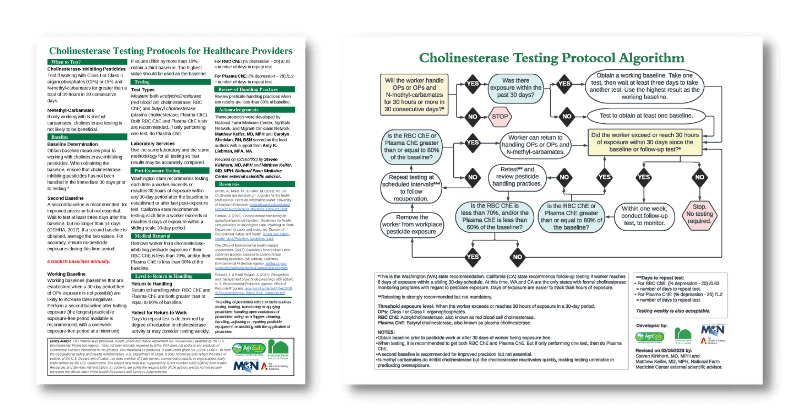Latinas are experiencing high rates of sexually transmitted diseases (STDs), teen childbearing, and unintended pregnancy. This report presents nine recommendations for sexual and reproductive health clinics and providers to increase young Latina women’s access to reproductive health services. The recommendations are based on findings derived from 14 focus groups conducted by Child Trends in three cities in the United States with young adult Latina women (18-24 years-old) and with reproductive health care and social service providers serving large Latina populations.
New research out of Cornell University's College of Human Ecology found that low-income children of immigrants have much poorer health than low-income children of citizens, as reported in a special section of the journal Child Development.
http://www.farmworkercliniciansmanual.com
This comprehensive manual was developed by the New York Center for Agricultural Medicine and Health and the Migrant Clinicians Network for the diagnosis and treatment of occupational injuries in migrant and seasonal farmworkers. The information in the manual does focus on agricultural occupations in the Northeast.
In honor of Mother’s Day, we’re proud to announce that our Safe Pregnancy and Birth mobile app is now available for free as a beta release for Android phones. Click here to download it now from the Google Play app store. In January, we released our app for iPhones; click here to download it from the Apple store. If you don’t have an Android or iPhone, you can preview the app here
- http://e2ma.net/go/11032126792/208891732/234042635/35444/goto:https://play.google.com/store/apps/details?id=org.hesperian.safepregnancyandbirth
- http://e2ma.net/go/11032126792/208891732/234042636/35444/goto:http://itunes.apple.com/us/app/safe-pregnancy-and-birth/id496919735?mt=8
- http://e2ma.net/go/11032126792/208891732/234042637/35444/goto:http://hesperian.org/books-and-resources/safe-pregnancy-and-birth-mobile-app/

These Cholinesterase (ChE) clinical tools provide a concise and simple format to guide clinicians in monitoring the ChE levels for patients working with Class I and Class II organophosphates (OP) or OP and N-methyl-carbamates.
An Action Plan for Implementing a Primary Care Clinician’s Evidence-Based Toolbox and Guide.
- CRC Action Plan brochur PAGE 1-11_0.pdf (621.73 KB)
One page document designed to educate clinicians about important elements of colorectal cancer screening using fecal occult blood tests (FOBT). Provides state-of-the-science information about guaiac and immunochemical FOBT, test performance and characteristics of high quality screening programs.
- FOBT Clinician's Reference Final 2012_0.pdf (298.33 KB)
This is a comprehensive, practical toolkit for primary care sites to implement more effective colon screening practices. Even though highly effective methods of CRC screening are available across the country, the current rates of screening, and of complete diagnostic examination that should flow from screening, remain inadequate. Thus, the potential benefits of widespread CRC are unrealized. The American Cancer Society has established the goal of 75 percent of the eligible population screened for CRC by the year 2015. This guide will help us reach that goal.
- acspc-024588sm.pdf (1.95 MB)
This booklet is intended to help Community Health Centers put in place an effective and efficient workers' compensation program.
- MedicalServicestoWorkers-2012.03.27.pdf (5.57 MB)
To provide guidelines for a thorough and consistent management of immunizations to our Clients throughout the Waimanalo Health Center.
- 2004+immunization+protocol.doc (35 KB)
Hidden Harvest is a nonprofit organization that gleans or rescues produce from Coachella Valley fields and packing houses. After harvest is complete, local farmers leave millions of dollars worth of first-rate produce behind in the fields due to market fluctuations and other factors.
Hidden Harvest takes advantage of this bounty and delivers the healthy produce free-of-charge to agencies that serve the hungry and needy
Hidden Harvest's mission is twofold - 1) to hire low income farmworkers at $10 per hour (above prevailing wage) to 2) to"rescue" or glean fresh, healthy and locally grown food from farmers' fields and area packing houses to feed the poor and hungry.
A depression diagnosis that warrants treatment or treatment change, needs at least one of the first two questions endorse as positive (little pleasure, feeling depressed) indicating the symptom has been present more than half the time in the past two weeks.
In addition the tenth question about difficulty at work or home or getting along with others should be answered at least "somewhat difficult".
When a depression diagnosis has been made patient preferences should be considered, especially when choosing between treatment recommendations of antidepressant treatment and psychotherapy.